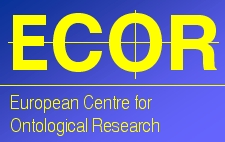Werner Ceusters
Barry Smith |
Referent Tracking
for Digital Rights Management
Digital Rights Management covers the description, identification, trading, protection, monitoring and
tracking of all forms of rights over both tangible and intangible assets, including management of
relationships between rights holders in a digital environment. The Digital Object Identifier (DOI) system
provides a framework for the persistent identification of content in its broadest interpretation. Although
the system has been very well designed to manage object identifiers, some important questions related to
the assignment of identifiers are left open. The paradigm of a referent tracking system (RTS) recently
advanced in the healthcare and life sciences environment is able to fill these gaps. This is demonstrated
by pointing out inconsistencies in the DOI models and by showing how they can be corrected using an
RTS. |
|
Barry Smith
Werner Ceusters
|
An Ontology-Based Methodology for the Migration of Biomedical Terminologies to Electronic Health
Records
Biomedical terminologies are focused on what is general, Electronic Health Records (EHRs) on what is
particular, and it is commonly assumed that the step from one to the other is unproblematic. We argue that
this is not so, and that if the EHR of the future is to fulfill its promise then work still needs to be
done in reconceiving the foundations of both EHR architectures and medical terminologies. We describe a new
framework for the treatment of both generals and particulars in biomedical informatics that is designed: 1.
to provide new opportunities for the sharing and management of data within and between healthcare
institutions, 2. to facilitate interoperability among different terminology and record systems, and thereby
3. to allow new kinds of reasoning with biomedical data. |
Accepted for AMIA 2005 |
Werner Ceusters
Barry Smith |
Strategies for Referent
Tracking in Electronic Health Records
The goal of referent tracking is to create an ever-growing pool of data relating to concrete entities in
reality. In the context of Electronic Healthcare Records (EHRs) the relevant concrete entities are not only
particular patients but also their body parts, diseases, therapies, lesions, and so forth insofar as these
are relevant to their diagnosis and treatment. Within a referent tracking system, all such entities are
referred to explicitly, something which cannot be achieved when familiar concept-based systems are used in
what is called “clinical coding”. In this paper we describe the components of a referent
tracking system in an informal way and we outline the procedures that would have to be followed by
healthcare personnel in using such a system. We argue that the referent tracking paradigm can be introduced
with only minor – though nevertheless ontologically important – technical changes to existing
EHR infrastructures, but that it requires primarily a different mindset from that which has prevailed
hitherto. |
Draft for IMIA WG6 2005 Conference Proceedings |
Barry Smith
Werner Ceusters
Bert Klagges
Jacob Köhler
Anand Kumar
Jane Lomax
Chris Mungall
Fabian Neuhaus
Alan Rector
Cornelius Rosse |
Relations in Biomedical Ontologies
The background to this paper is the recognition that many biological and medical ontologies can be improved
by adopting tools and methods that bring a greater degree of logical and ontological rigour. We describe
one endeavour along these lines, which is part of the current reform efforts of the Open Biomedical
Ontologies (OBO) consortium and which has implications for ontology construction in the life sciences
generally.
OBO ontologies consist of controlled vocabularies which can be conceived as graph-theoretical structures
organized by means of links or edges called ‘relations’. Unfortunately too little attention has
been paid to the nature of such relations and of the relata which they join together. How, exactly, should
part_of or located_in be defined in order to ensure maximally reliable curation of each single ontology
while at the same time guaranteeing maximal leverage in building a solid base for life-science knowledge
integration in general?
We describe a rigorous methodology for providing answers to such questions and illustrate its use in the
construction of a simple and easily extendible list of ten relations of a type familiar to those working in
the bio-ontological field. This list forms the core of the new OBO Relation Ontology. What is distinctive
about our methodology is that, while the relations are each provided with rigorous formal definitions,
these definitions can at the same time be formulated in such a way that the underlying technical details
remain invisible to ontology authors and curators. |
Genome Biology 2005,
6:R46
doi:10.1186/gb-2005-6-5-r46 |
Barry Smith
Werner Ceusters
Rita Temmerman |
Wüsteria
The last two decades have seen considerable efforts directed towards making electronic healthcare records
interoperable through advances in record architectures and through improvements in medical ontologies,
terminologies and coding systems. Unfortunately, these efforts have been hampered by a number of
influential ideas inherited from the work of the father of terminology standardization Eugen Wüster,
founder of ISO TC 37. We survey these ideas, which see terminology work as being focused on the
classification of concepts in people’s minds, and we argue that they have formed the basis for a
series of still influential confusions. We argue that an ontology based unambiguously on the classification
of entities (both universals and particulars) in reality can, by removing these confusions, make a vital
contribution to assuring the interoperability of coding systems and healthcare records in the future. |
Accepted for MIE 2005 |
Werner Ceusters
Barry Smith |
Tracking Referents in Electronic
Healthcare Records
Electronic Healthcare Records (EHCRs) are organized around two kinds of statements: those reporting
observations made, and those reporting acts performed. In neither case does the record involve any direct
reference to what such statements are actually about. They record not: what is happening on the side of the
patient, but rather: what is said about what is happening. While the need for a unique patient identifier
is generally recognized, we argue that we should now move to an EHCR regime in which all the particulars to
which reference is made in clinical statements should be uniquely identified. This will allow us to achieve
interoperability among different systems of records at the level where it really matters: in regard to what
is happening in the real world. It will allow us to keep track of particular disorders and of the effects
of particular treatments in a precise and unambiguous way. We discuss the ontological and epistemological
aspects of our claim and describe a scenario for implementation within EHCR systems. |
Accepted for MIE 2005 |
Lowell Vizenor
Barry Smith
Werner Ceusters |
Foundation for the Electronic Health Record:
An Ontological Analysis of the HL7’s Reference Information Model
Despite the recent advances in information and communication technology that have increased our ability to
store and circulate information, the task remains of ensuring that the right sorts of information reach the
right sorts of people. In what follows we defend the thesis that efforts to develop efficient means for
sharing information across healthcare systems and organizations would benefit from a careful analysis of
human action in healthcare organizations, and that the communication of healthcare information and
knowledge needs to rest on a sound ontology of social interaction. We illustrate this thesis in relation to
the HL7 RIM, which is one centrally important tool for communication in the healthcare domain. |
|
Werner Ceusters
Barry Smith
Georges De Moor |
Ontology-Based Integration of Medical Coding Systems and Electronic Patient Records
In the last two decades we have witnessed considerable efforts directed towards making electronic
healthcare records comparable and interoperable through advances in record architectures and (bio)medical
terminologies and coding systems. Deep semantic issues in general, and ontology in particular, have
received some interest from the research communities. However, with the exception of work on so-called
‘controlled vocabularies’, ontology has thus far played little role in work on standardization.
The prime focus has been rather the rapid population of terminologies at the level of fine detail. In this
paper, we argue that more efforts are needed on the side of both research and standardization to ensure
that the coding systems used in electronic healthcare records enjoy a semantics that is coherent with the
semantics of the record. We propose realist ontology as a method to bring about this coherence by means of
a robust system of top-level ontological categories. |
|
Werner Ceusters
Barry Smith
Louis Goldberg |
Louis Goldberg
A Terminological and Ontological Analysis of the NCI Thesaurus
Objective: The National Cancer Institute Thesausus is described by its authors as a biomedical
vocabulary that provides consistent, unambiguous codes and definitions for concepts used in cancer
research and which exhibits ontology-like properties in its construction and use. We performed a
qualitative analysis of the Thesaurus in order to assess its conformity with principles of good practice in
terminology and ontology design.
Materials and methods: We used both the on-line browsable version of the Thesaurus and its
OWLrepresentation (version 04.08b, released on August 2, 2004), measuring each in light of the requirements
put forward in relevant ISO terminology standards and in light of ontological principles advanced in the
recent literature.
Conclusion: Version 04.08b of the NCI Thesaurus suffers from the same broad range of inconsistencies
that we have observed in other biomedical terminologies. For its further development, we recommend the use
of a more principled approach that allows the Thesaurus to be tested not just for internal consistency but
also for its degree of correspondence to that part of reality which it is designed to represent. |
Accepted by Meth Info Med |
| Other publications relevant to ECOR's
mission |



